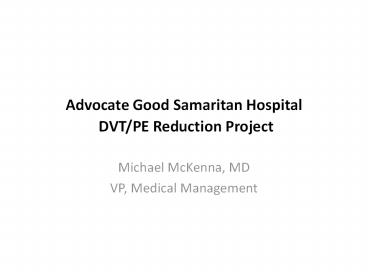Advocate Good Samaritan Hospital DVT/PE Reduction Project - PowerPoint PPT Presentation
1 / 11
Title:
Advocate Good Samaritan Hospital DVT/PE Reduction Project
Description:
Advocate Good Samaritan Hospital DVT/PE Reduction Project Michael McKenna, MD VP, Medical Management Opportunity DVT/PE Trend Medical Overall 64% medical vs 36% ... – PowerPoint PPT presentation
Number of Views:126
Avg rating:3.0/5.0
Title: Advocate Good Samaritan Hospital DVT/PE Reduction Project
1
Advocate Good Samaritan Hospital DVT/PE
Reduction Project
- Michael McKenna, MD
- VP, Medical Management
2
Opportunity
3
DVT/PE Trend Medical
Overall 64 medical vs 36 surgical
4
DVT/PE Trend Surgical
Overall 64 medical vs 36 surgical
5
Define Opportunity Team Charter
Linkage to Strategic Plan Quality, Physician
Partnership, Service, and Finance
Pillars Problem Statement The DVT/PE
complication rate presents an opportunity for
improvement for Good Samaritan Hospital. The
current DVT/PE complication rate per 1000 is
26.3. Benefits Positive impact on patient
outcomes (decreased morbidity, increased quality
of life, decreased mortality, shorter
hospital stay) and patient satisfaction (happy
with the quality and service they received
because they did not develop a complication of
hospitalization). Scope The team will
implement a Performance Improvement methodology
focusing on a data, measurement, and prompt and
appropriate prophylaxis to reduce the DVT/PE
complication rate for both medical and surgical
patients. Process will be analyzed from admission
to discharge. Goals Specification Limit
(minimum goal) complication rate of 23.7 pre
1000. Target complication rate of 21.0 per
1000.
Sponsor Dr. McKenna
Project/Process Owner Improvement
Leaders D.Calcagno, T.Esposito
Milestones Description Date (mo/yr) 1 2 3
- Key Metrics
- Medical DVT/PE complication rate
- Surgical DVT/PE complication rate
- Proper DVT prophylaxis utilization
6
Improving the Assessment Process
- Accountability moved to nursing
- CareConnection Task/prompt
- Revamped assessment form
- Risk assessment
- Prophylaxis guidelines
- Standard Work
- Procedure for completion and physician
notification - Potential failure modes identified and addressed
(e.g. shift change) - Audit process
- Pilot
- Rapid cycle small test of change
- 43 completed assessments on pilot unit
- 65 of patients scoring high and highest
categories
7
Initial Assessment Results
65 of patients scored High or Highest Risk
Data Source Care Connection- Patients
Discharged 11/01/2007-01/31/2008
8
Assessment Results
- Sustained completion rate of 98
- Assessment process also validated for accuracy
and reliability
Data Source Care Connection- Patients
Discharged 1/1/2008-9/30/2008
9
Improve Prophylaxis
- VTE cases discharged between 8/2007 and 3/2008
were reviewed (n 40) - DVT/PE was hospital acquired (not present on
admission) - Demographic, administrative, and clinical data
reviewed - 68 (n 27) did not receive optimal
pharmacological prophylaxis - Largest opportunity included circulatory cases
30 of all DVT/PE cases reviewed grouped into a
circulatory MDC
10
DVT/PE Case Drilldown
- Circulatory cases
- N size 12
- 92 (n 11) surgical cases
- 83 (n 10) did not receive optimal chemical
prophylaxis
11
Next Steps
- Case by case review of VTE cases by physicians
- Verification of optimal prophylaxis
- Follow-up/feedback to individual physicians
- Leverage existing anticoagulation subcommittee
for other DVT/PE reduction strategies































